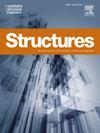Performance of hybrid basalt-recycled polypropylene fibre reinforced concrete
IF 3.9
2区 工程技术
Q1 ENGINEERING, CIVIL
引用次数: 0
Abstract
This study investigated the influence of hybrid basalt-recycled polypropylene (PP) fibre reinforcement on the mechanical properties of concrete at various volume fractions. Various volume fractions of basalt micro fibres (0.1 % and 0.3 %) and recycled PP macro fibres (0.3 %, 0.7 %, and 1.0 %) were examined. The results showed significant improvements in compressive strength, flexural performance, and energy absorption capacity compared to plain concrete. The optimal mixture (0.3 % basalt and 0.7 % recycled PP) achieved a 64 % increase in flexural strength. Compressive strength increased by up to 13.2 % with 0.3 % basalt and 0.3 % recycled PP. Hybrid reinforcement also enhanced post-cracking behaviour and energy absorption, with the highest energy absorption reaching 20 J, nearly tenfold that of plain concrete. Virgin PP fibres predominantly failed by rupture, indicating strong fibre-matrix bonding, while recycled PP fibres mainly failed by pull-out. The modulus of rupture of recycled PP reinforced concrete (3.76 MPa) was only marginally lower than virgin PP one (4.52 MPa). Importantly, the post-peak strength of virgin and recycled PP reinforced concrete (B01VP07 and B01P07, respectively) remained comparable at approximately 2.5 kN. This study demonstrated the effectiveness of using the basalt recycled PP fibre reinforcement and highlighted its potential as a sustainable solution for enhancing concrete performance.
求助全文
约1分钟内获得全文
求助全文
来源期刊

Structures
Engineering-Architecture
CiteScore
5.70
自引率
17.10%
发文量
1187
期刊介绍:
Structures aims to publish internationally-leading research across the full breadth of structural engineering. Papers for Structures are particularly welcome in which high-quality research will benefit from wide readership of academics and practitioners such that not only high citation rates but also tangible industrial-related pathways to impact are achieved.
 求助内容:
求助内容: 应助结果提醒方式:
应助结果提醒方式:


